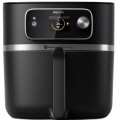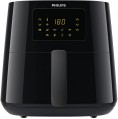Number of programs
The total number of cooking programs provided in the device.
The more this number — the more extensive the possibilities, the wider the choice of the user. However, note that a specific set of modes may be different, this point in each case should be clarified separately. See "Programmes" for details on specific modes.
Programmes
Cooking programs provided in the device. The most common cooking programs are:
fries,
chips,
chicken,
meat,
shrimps,
fish,
pizza,
vegetables.
— Fries. The fryer offers a specialized automatic cooking program designed specifically for preparing dishes like crispy potatoes, mushrooms, or meat in batter. While these dishes can be cooked in any deep fryer, this program simplifies the process. With this program, users no longer need to manually monitor the cooking time and temperature. They simply load the ingredients, select the appropriate mode, start the cooking process, and wait for it to complete. In multi-ovens and air fryers, this type of cooking can be achieved with minimal amounts of oil or even without oil at all, providing healthier cooking options.
— Chips. The fryer offers a dedicated cooking program specifically designed for making potato chips, which are thin and crispy slices of potato. While chips can be cooked in any deep fryer, if the device does not have a built-in cooking program, users will need to manually configure the cooking parameters and closely monitor the process. Alternatively, the option to cook chips may also be available in multi-ovens and convection ovens (
...see "Type"), expanding the cooking possibilities beyond traditional deep fryers.
— Chicken. A cooking program specifically designed for cooking chicken meat is commonly available in multi-ovens and air fryers. This program typically involves baking the chicken. However, deep fryers are less commonly equipped with this specific program. In deep fryers, the emphasis is usually on frying chicken with batter or without it.
— Meat. Program for cooking meat (veal, pork, etc.). It is used mainly in multi-ovens and air fryers, which means roasting meat.
— Shrimps. A cooking program specifically designed for cooking shrimps is commonly available in deep fryers, which typically allow frying shrimp in tempura batter. Air fryers and multi-ovens, on the other hand, may offer different cooking options for shrimps, such as boiling, particularly in the case of multi-ovens.
— Fish. Programme for cooking fish. In deep fryers (see "Type") fish is most often cooked in batter, in small pieces; it is possible to bake the whole fish, if the volume of the working space allows it in multi-ovens and air fryers.
— Pizza. A programme optimized for pizza making. The "Pizza" program, commonly found in multi-ovens, ensures that Italian dishes, as well as casseroles and pies, are cooked evenly on all sides. This program is designed to create a crispy crust on the top while maintaining a juicy filling inside.
— Vegetables. The "Vegetables" program, commonly available in multi-ovens, is characterized by its moderate temperature setting. It allows for slow and gentle heating of vegetables, similar to stewing. This program is ideal for preparing various vegetable-based dishes such as side dishes, stews, complex dishes and soup dressings.
— Auto-cooking. In addition to those described above, the design may also provide for other types of auto-cooking programs — for example, for mushrooms, barbecue, baking bread, etc.Modes
—
Frying. The frying mode provides work at a high temperature. And for deep-frying, the multi-oven can be equipped with special baskets.
—
Grill. Specialized mode for cooking juicy steaks, golden crispy breadcrumbs, grilled fish, grilled vegetables, etc. Multi-ovens with this function are usually equipped with a special grill kit — a removable bottom with typical ribs and holes, small skewers for cooking meat or vegetable kebabs.
—
Baking. The possibilities of this mode are in many ways similar to a conventional oven. Baking usually means the cooking of not only flour products, but also muffins, various casseroles, etc.
—
Drying. The drying mode is used to remove moisture from various food items by subjecting them to prolonged, low-temperature heating and hot air circulation. This mode is commonly employed for dehydrating vegetables and fruits for long-term storage, preparing dried meat or fish for outdoor activities such as hiking, and other similar purposes.
—
Defrosting. Special mode for gentle defrosting of frozen food. It maintains a low intensity of the multi-oven, so that the contents effectively “melt”, but at the same time do not bake.
—
Reheating. Reheating refers to the process of warming up pre-cooked dishes
...rather than cooking raw food. In the reheating mode, the temperature is maintained at a relatively low level to gently warm the food without overcooking it. Some models may offer an initial burst of intense heat followed by a lower temperature to efficiently heat the dish and then keep it warm.
— Heating. The preheat function is used to heat the cooking container before placing the ingredients inside. This mode quickly heats the bowl of the multifurnace to a high temperature, such as 200 °C, within a short period, typically 3-4 minutes. This ensures that the container is adequately heated and ready for cooking.cooking t
The cooking temperature provided by the device. Most models are adjustable, so this item indicates the operating temperature range.
Deep frying is carried out at temperatures from 130 to
190 °С200 °С. But
high operating temperatures (over 200°) are less common.
Basket capacity
The capacity of the deep fryer basket or multi-oven bowl, or air fryer flask (see "Type") in kilograms is the maximum amount of food that can be loaded into the device at one time.
For deep fryers used in everyday life, a capacity of up to 0.6 – 0.8 kg is considered quite sufficient; it is rarely useful to fry numerous foods at a time at home. But models that can hold from a kilogram or more are designed mainly for industrial use — in cafes, canteens, etc. In turn, multi-ovens with a capacity of up to 0.8 kg can be called small, up to 1.5 kg — medium, more than 1.5 kg — large. Air fryers have approximately the same capacity.
Volume
The volume of the multi-cooker bowl, deep fryer basket, air fryer container, or the cooking chamber of a multi-oven.
This parameter is measured in liters and is directly related to the capacity of the basket (see above) — larger volumes are required for a greater quantity of food. For deep fryers (see "Type"), this parameter is usually specified not by the total volume but by the amount of oil needed for standard operation, providing an estimate of how much oil is required for the appliance. In models with separate compartments (see below), the volume may be indicated for each section individually.
Timer
The type of timer provided in the design of the device.
The
timer itself is a device for controlling the cooking time: it measures a user-specified period of time and at the end of it gives a signal, and in some models it also stops heating. And the types of such devices can be as follows:
— Mechanical. A basic type of timer commonly found in appliances is a mechanical timer, often in the form of a specialized knob. To set the timer, the knob is turned to the desired time division, and it rotates in the opposite direction, counting down the time. Mechanical timers are known for their simplicity, reliability, and affordability. However, they are not highly accurate, typically allowing time to be set with a precision of one or two minutes. Over time, the knob may become loose, further reducing the accuracy of the timer setting. Nonetheless, for most purposes, this level of accuracy is sufficient.
— Electronic. An electronic timer is set using electronic circuits and is equipped with a display that shows the set time and the countdown. The key advantage of electronic timers is their high accuracy, allowing time to be selected with precision down to the second. However, electronic timers are more complex and expensive compared to mechanical timers.
Power consumption
The power consumed by the device during operation. Usually indicated by the maximum energy consumption, at the most intensive mode of operation.
Large capacity requires more power. However, devices with similar characteristics may differ in this parameter. It is worth noting that, other things being equal, lower power does not mean more economical energy consumption: cooking in such a device takes more time and as a result, the amount of energy spent is almost the same. At the same time, lower power means less load on the electrical grid, which can be important in houses with poor wiring.
Control
—
Rotary switch. Control carried out by mechanical elements directly connected to the corresponding components of the device. The traditional, most popular option provides two rotary knobs: a thermostat and an off timer with a clock mechanism (see “Functions”). The main advantages of this type of control are simplicity and low cost. At the same time, the capabilities of the “mechanics”, although modest, are quite sufficient to control all key functions. Among the clear disadvantages compared to electronic control, it is worth noting less accuracy.
-
Push-button. Push-button control is based on electronic circuits. Such systems are more accurate than mechanical ones; more capabilities and modes are provided. On the other hand, such control is more complex and more expensive than mechanical control.
-
Touch. A type of
electronic control with touch switches. Compared to push-button models, it provides a high level of comfort in operation, and looks more modern and aesthetically pleasing. Touch control is found mainly in top models of juicers.
—
Rotary switch with sensor. Another type of electronic control, where the main control is a rotary switch, which is complemented by touch buttons. The switch itself simplifies the selection of modes, temperature, timer time, and the sens
...ors are secondary. However, the control panel itself looks stylish and is not inferior in design to models with touch controls only.
